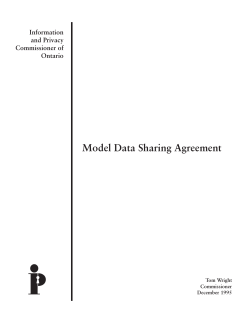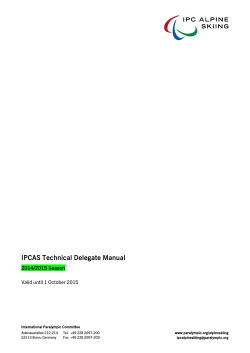
Document 247522
TRACE LABORATORIES, INC 5 North Park Drive Hunt Valley, MD 21030 USA Telephone: 410/584-9099 410/584 / Fax: 410/584-9117 Website: www.tracelabs.com / Email: info@tracelabs.com Internationally Accredited Independent Testing Why not let those who have been contributing to IPC specifications for more than 25 years help you with qualification, acceptance and conformance of your products and surveillance of your Preferred Supplier List (PSL)? Trace welcomes new IPC President, John Mitchell Debora Obitz (27-year year IPC Member) and John Mitchell at IPC Midwest Debora was recognized for her contribution to IPC IPC-HDBK-850 850 Want to scan the highlights from the latest IPC meeting held in Schaumburg, IL in August 2012? 2012 Renee Michalkiewicz (17-year year IPC member), John Radman (23 (23-year year IPC member), Keith Sellers (2-year (2 IPC member) and Debora Obitz (27-year year IPC member) share their thoughts. D-31b (IPC-2221 Printed Board Design Design) – The new revision is complete and pending consensus vote. The 110 coupon committee requested that the critical comments, that were previously reviewed and discussed, are included such as the location of the registration coupon. D-55 (Embedded Embedded Devices Process Implementation Subcommittee Subcommittee) – The meeting centered on establishing the committee’s KAVI website. ISO 17025 See Scope TRACE LABORATORIES, INC 5 North Park Drive Hunt Valley, MD 21030 USA Telephone: 410/584-9099 410/584 / Fax: 410/584-9117 Website: www.tracelabs.com / Email: info@tracelabs.com Internationally Accredited Independent Testing 3-11: (IPC-4101 4101 Laminate/Prepreg Materials Subcommittee) – The major discussion focused on the UL classification of FR-4 laminate. The he UL STP vote for a one bucket and four bucket systems system failed to pass. Neither proposal can be voted on again. Tony Senese from Panasonic, the group’s chair, suggested that the IPC Laminate and Prepreg Subcommittee propose a new system for Re Re-Classifying FR-4. The T new system would consist of two buckets each with its own MCIL program - one brominated and one halogen-free. halogen There would still be an “all other” group for CCL that do not fit either of the MCIL buckets. These would require testing. This proposal was well received by the group group, and a proposal will be presented to UL. Renee Michalkiewicz (Top row, 4th from the right) was recognized for her contribution to IPC J-STD-002D J 4-14: 14: (Plating Processes Subcommittee) – Discussions involved revisions to the following specifications, IPC ENEPIG-4556 and IPC ENIG 4552.. Comments were reviewed, appendices were discussed and actions assigned. 4-33a (Low-Halogen Halogen Guideline Task Group IPC-4903) - The he meeting was focused on the t discussion and debate of 100+ comments to the revision of IPC IPC-4903 “Guideline for Defining ‘Low-Halogen’ Halogen’ Electronic Products” 5-23a (IPC/J-STD-003 PCB Solderability) – There was a request to reinstate the edge dip and solder float test until replacements ts tests are available. The industry needs methods to use to determine acceptability. Gerard O’Brien was reluctant to do this since it apparently had been voted in the task group to delete those methods since they are not representative of what a PB actu actually ally sees during soldering. The durability categories were removed from the specification. ISO 17025 See Scope TRACE LABORATORIES, INC 5 North Park Drive Hunt Valley, MD 21030 USA Telephone: 410/584-9099 410/584 / Fax: 410/584-9117 Website: www.tracelabs.com / Email: info@tracelabs.com Internationally Accredited Independent Testing 5-23b (IPC/J-STD-002 Component Solderability) – The J-002 002 revision D is completed and barring any negative votes will be released. There was discussion concerning the round robin test on the solder paste aperture for Test Method S. 5-24a: (IPC J-STD-004 004 Flux Specifications Task Group) – Renee Michalkiewicz alkiewicz is the chair of this committee and the vice chair of the Assembly and Joining Committee. We are beginning the process of reviewing all of the J-STD-004 004 test methods. Five round robins will take place between Midwest and APEX. 5-24b: (IPC J-STD-005 005 Solder Paste Task Group) – We began reviewing some of the test methods that are called out in J-STD-005. 005. Viscosity testing of paste was discussed and some initial studies were scheduled to see if a small variation in temperature affects viscosit viscosity results. 5-24c (Solder Alloy Task Group) - The discussion focused on comments to the revision of J-STD-006 J as well as to IPC-TM-650, method 2.4.48. 5-32a (Ion Ion Chromatography/Ionic Conductivity Task Group Group) – All cleanliness methods are currently up-toup date. ate. John Radman, the chair of this group, opened discussion on the possibility of developing a method for component cleanliness testing. Method could possibly support counterfeit component testing. A draft method will be distributed to the group. 5-32b (SIR and Electrochemical Migration Task Group) – Keith Sellers is the chair of this task group. Revisions to the IPC-B-52 52 test board were reviewed, based on comments given at IPC APEX in Feb. These revisions are focusing on the addition of “other” patte patterns to the board – as possibly the start of an IPC SIR test pattern library. Additionally, dditionally, the use of underfills with the IPC IPC-B-52 52 test board was discussed. Doug Pauls from Rockwell Collins presented data that he had obtained based on internal studies pe performed rformed at this company. Rich Kraszewski from Plexus gave a short presentation on an ECM topic that HDPUG has been discussing. 5-33a (IPC-CC-830 830 Conformal Coating Coating) – This group will be doing a new revision for this document. So far there are two big debates ates in this committee: • Trying to find an acceptable adhesion test for coatings. Many users are requesting this as an incoming inspection test. Several tests have been discussed: cross hatch (we deleted this from the earlier revisions since it was not repeatable and had variable results across testers), tape test – there are 2 brands of 600 tape (office use and industry strength) each will give different results and the tape will not adhere to silicones, and scratch tests in ASTM – this test is not effective for silicones. • MIR values that were changed from 500 to 5000 with no gage R&R to back up the change. It is believed that when the document was mimicking the MIL MIL-I-46058 46058 (military document that was scheduled 10+ years ago for cancellation) it was cha changed nged at that point. However, it was not taken into consideration that the coupons used are different in spacing, thickness, and widths. They are checking into the correlation of the D and C patterns. This has been a recent discovery since there are more companies requesting testing to IPC IPC-CC-830 as of late. Testing to the CC-830, 830, at least in my TRACE LABORATORIES, INC 5 North Park Drive Hunt Valley, MD 21030 USA Telephone: 410/584-9099 410/584 / Fax: 410/584-9117 Website: www.tracelabs.com / Email: info@tracelabs.com Internationally Accredited Independent Testing observation, was minimal since we had the “Grandfather clause which states if you are qualified to the MIL-I-46058 46058 you are automatically qualified to the IPC IPC-CC-830. 830. Most tested to the military document and therefore met the IPC document. 5-33c (IPC-HDBK-830 Conformal Coating Handbook) – There are 45 of the 47 topics completed in this document. Six chapters were previously reviewed and chapters 2, 8, and 9 were reviewed in the last session. Chapters 3 and 4 were reviewed during this meeting and minor changes were made. 5-33f (Potting & Encapsulation) – We celebrated the release of the handbook. 7-11: (IPC-TM-650 650 Test Methods Subcommittee) – Renee Michalkiewicz icz is the chair of the general committee. The discussions focused on the newly published IPC IPC-TM-650 650 MDP (Method Development Packet). We discussed what data would be acceptable for method verification studies. Additionally, discussions continued on whether her IPC could be successful at beginning a laboratory proficiency program. 7-24 (Printed Board Process Effects) – We reviewed each section of the document and received a few manufacturing and supplier volunteers. This document is set to outline issues with manufacturing boards (Example: separation at the interconnect), and it will show a photograph and list all ooff the possible causes for the defect. Trace volunteered to supply photographs of defects. IPC-6012 and IPC-A-600) – Debora Obitz is the vice-chair vice of the general 7-31a/D-33a (Joint meeting of the IPC committee. Discussion revolved around the reduction in traces ces with Leo Lambert from the 610 group. The 610 group was concerned that since we give a reduction (20 (20-30%) 30%) due to defects (drill splay, nicks, scratches, mouse bites, etc) that IPC-A-610 610 in turn gives an additional reduction of 20% - it was discussed and an stated that the additional reduction cannot be conjoined with any reduction in the original trace. There was discussion concerning the new coupons designed for registration testing and additional discussion on cleanliness testing.
© Copyright 2025





















